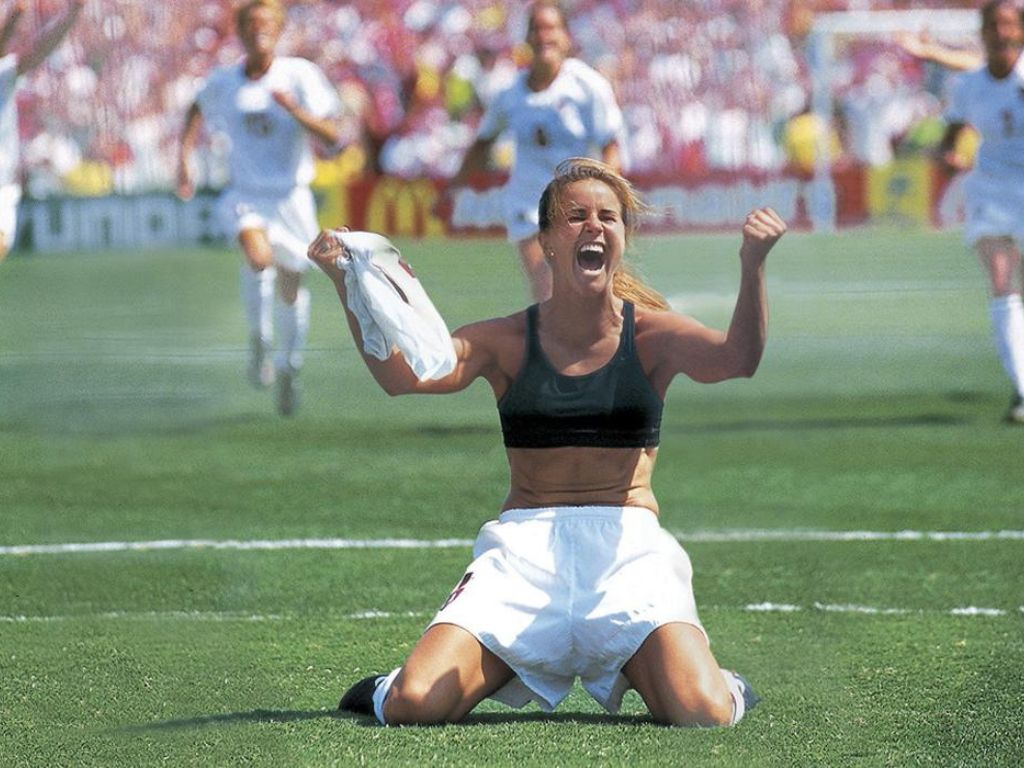Brought together for the new Starbucks and Amazon documentary series, “This is Football,” soccer player Brandi Chastain and photographer Robert Beck share what it was like to be on either side of a career-defining moment at the 1999 Women’s World Cup, and how their lives intersected – not once, but twice.
It’s one of the most iconic images in all of sports.
In the center of the frame is Brandi Chastain, shouting to the skies in celebration of her game-winning goal at the 1999 FIFA Women’s World Cup, her jersey off and clutched in one hand. On the other end of the lens was Robert Beck, a Sports Illustrated staff photographer who had never before even been to a women’s soccer game. Chastain and Beck, who share their stories in a bonus video for the new Amazon and Starbucks documentary series “This is Football,” tell what it was like to be on either side of that moment, and how their lives intersected – not once, but twice.
A watershed event
When Beck arrived at the Women’s World Cup final at the Rose Bowl in Pasadena, Calif., on July 10, 1999, he was assigned to shoot the match only from high up in the stands.
“I was not very aware of the sport. I bet you could count the number of soccer games I shot on two hands, maybe even one,” Beck said in an interview for the series. “I couldn’t believe how full (the stadium) was and especially, you know, I hate to say this, but almost for a women’s sporting event. And it was just packed and it was so hot and I thought, ‘What are these people doing?’”
For Chastain, the journey to get there had been a long and improbable one. When she signed up as an 8-year-old for her neighborhood soccer team in 1976, the world’s game had not captured the American imagination. Among boys, only 115,000 high school athletes played soccer at the time – only a tenth of the number playing American football according to the National Federation of State High School Associations. Among girls, that number was even lower, with only 600 girls’ soccer teams and less than 12,000 players. But Chastain was on the cusp of an explosion in sports participation for young female athletes thanks to the 1972 federal civil rights law, known as Title IX, which prohibited sex discrimination in education.
“The popularity of soccer in America when I was growing up was fairly low in comparison to all the other sports that we had,” Chastain said. “I got a lot of, ‘Why are you playing that immigrant sport, that foreign sport?’ I think maybe that made my resolve even stronger. ‘Oh yeah, just wait, you’re going to fall in love with this game as well.’”
There were few female athletes as role models. And those who were in the public eye tended to be the ones competing in skirts or leotards, not muddy cleats and shin guards. Chastain found heroes where she could, emulating male soccer stars like George Best and Franz Beckenbauer.
Watching the U.S. beat Russia in ice hockey in the 1980 Winter Olympics, the outlines of a dream were beginning to take shape. “I thought, I want to do that… I want to represent the U.S. But even that was like, ‘Hmm, kind of crazy because it doesn’t exist!’,” said Chastain. Women’s soccer wouldn’t become an Olympic sport until years later – but when it did, Chastain was there to be part of it.
She had earned a scholarship to play soccer at Santa Clara University and then joined the roster for the first-ever Women’s World Cup in China 1991 (earning just $10 a day). When women’s soccer debuted as an Olympic sport in Atlanta in 1996, she was on the field as a member of the team.
“The American public virtually had no idea what was happening, which is not their fault,” she said. “Because women’s soccer lived in anonymity for so long, we wanted to have it shared. We weren’t doing it for trophies or fame, we did it because we loved soccer and we chose soccer.”
In the summer of 1999, the United States hosted the second Women’s World Cup, taking a gamble by scheduling the matches in big stadiums typically used male sporting events. After an electrifying three-week tournament, the crowd of more than 90,000 that had gathered to watch the final between the United States and China was the largest-ever for a women’s athletic event. ABC’s game-day commentator Robin Roberts called it a watershed event for the country. “What we’re seeing clearly transcends sports,” she told viewers. “This is a moment in American culture.”
Under sunny skies and intense Southern Californian heat, the U.S. and China battled for 90 scoreless minutes, followed by another exhausting 30 minutes of overtime that sent the game into tie-breaking penalty kicks. That’s when Beck, the photographer, decided to make his move down to a spot right behind the goal, despite not having a field credential.
“I’d been to the Rose Bowl a hundred times, I knew where to go to get on the field and I was just kind of keeping my fingers crossed that no one would say anything,” Beck said in an interview for the film.
Chastain wasn’t slated to take a penalty kick until sixth, stepping up only if the score remained tied after each side took five kicks. At the last minute, she was bumped up to the fifth spot. Four consecutive goals by the first U.S. kickers and a save by American goalkeeper Briana Scurry meant that a goal by Chastain could win the game. “I don’t even remember any of the other kicks, but at that time you’re feeling the crowd and it’s really loud and when it comes to Brandi’s, you know everything’s on the line,” Beck said.

‘Best feeling ever’
Chastain took the ball and placed it on the penalty spot, avoiding eye contact with the goalkeeper. While behind the net, Beck trained his camera on the kicker. Both were lining up the perfect shot.
“I remember the moment as being absolutely dead silent,” Chastain said. “You know, you could hear a pin drop. Not a peep from anyone.”
“How I framed it was to have Brandi in the middle, but her team is so out of focus and the depth of field is so small that, that she’s just singled out,” Beck said. “She really was all alone in that moment.”
Once the referee blew her whistle, Chastain made her run up to the ball and perfectly struck it with her left foot, sending it just inside the goal post and past the outstretched fingertips of China’s goalkeeper Gao Hong. The game won, Chastain spun around and ripped off her jersey, sliding to her knees in her black sports bra as her teammates ran to join her from midfield.
Chastain remembered, “The flash bulbs, the sound, the goosebumps, the emotions, all of them incredibly genuine, and just phenomenal. Best feeling ever.”
Beck watched the scene unfold through his lens. “I’m just looking through this square and I can see all the players running towards her,” he said. “This is in film days so I have 36 frames at the most, so I just can’t burn it all. When she went to her knees and began her celebration most of that just went out the window. I was very lucky that Brandi stayed within, like one square of that frame.”
That moment would change the trajectory of two lives, and perhaps countless others.
The next week, Beck’s photo ran on the cover of Sports Illustrated, a close shot of Chastain with the simple headline, “Yes!” The image marked a new chapter in women’s sports, an expression of the strength and resilience of a generation of female athletes and an inspiration for generations more. It would go on to become one of SI’s iconic covers ever, second only to a photo of the “Miracle on Ice” that had inspired Chastain almost 20 years earlier.
Epilogue
After a few weeks, Chastain’s goal slipped into memory for Beck. He shot hundreds of other events in other cities. Five or 10 years later he was photographing a basketball tournament in the Bay Area when he saw her working as a TV commentator and decided to introduce himself.
“I said, my name’s Robert Beck, I’m the guy who took the picture that was on the cover of Sports Illustrated,” Beck said. Chastain jumped on him and wrapped her arms and legs around him, screaming – almost crying.
“She looks at me and she says, ‘You don’t understand what an impact that made on hundreds of thousands of girls in our country, let alone around the rest of the world,’” Beck said. “I didn’t realize that.”
That image showed that young girls and women could have their own heroes, their dreams could fully take shape. They didn’t have to hide their athleticism. They could be sweaty and unapologetic and strong. And it proved football, the world’s game – the beautiful game – was in America to stay.
“There are certain things that happen to sports, it’s such a gift,” Chastain said. “Robert’s world and my world came together at the exact time it should to make that moment happen. You know, a picture is worth a thousand words, or a million, or maybe that’s not enough anymore.”
Jennifer Warnick contributed to this report





